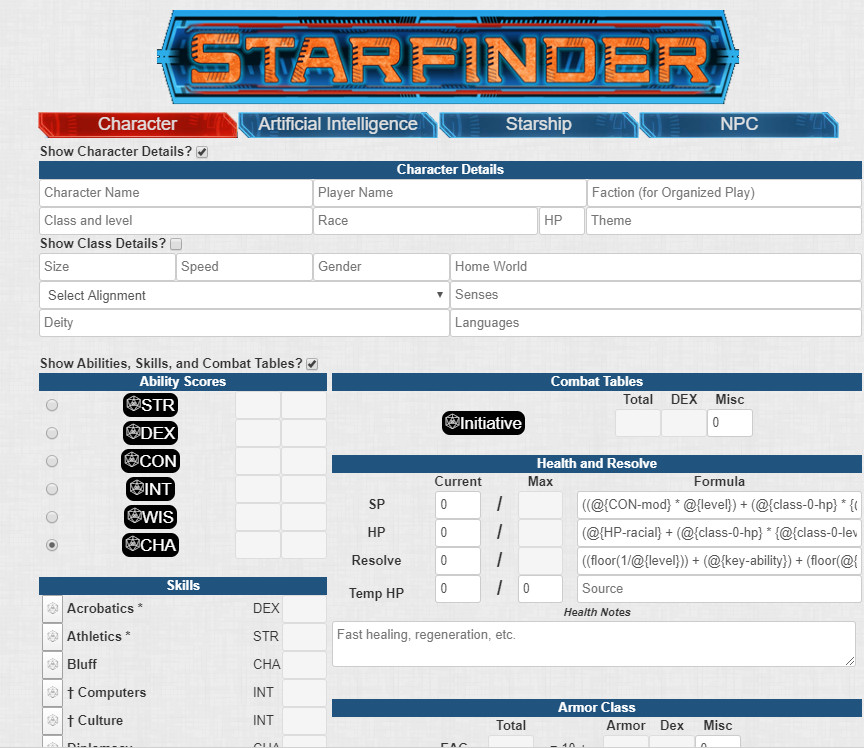Starfinder simple
From Roll20 Wiki
Page Updated: 2021-09-24 |
The sheet was created through heavy modification of the Pathfinder (old) sheet created by Samuel Marino.
Join the Conversation
Have a question? Noticed a bug? Got a feature request? Want to see what new features are being added? Stop by the Work In Progress (WIP) campaign.
The Sheet
The Character sheet is comprised of four tabs. You will most likely only use one of these tabs for a character. Which tab you use will be based on what data you want to capture.
- Character: This is where you will put all of your character's information necessary for play. There are several clickable buttons that run useful macros and many of the blocks have attributes keyed to them that can be used in macros created by the players. To find the name of an attribute, simply mouse over the block and wait for the text name to appear.
- Artificial Intelligence: This tab is used for recording the information associated with a Mechanic's Drone or to present the abilities of the Mechanic's Exocortex. There are buttons that call for macros and once again most blocks can be referenced by an attribute name.
- Starship: This is the character sheet for a space craft. It contains all of the data required for starship combat as well as several buttons keyed to useful macros. See the Starship Feature below for information on how to make the most of this tab.
- NPC: Here you will find a simple character sheet to be used by the Game Master (GM) for entering only the most basic of data for a Non-Playing Charater (NPC) or monster.
Character Tab
The first section of this tab is Character Details. This is where you will put in your Name, class, race, and other basic data. The details about your character's class can be recorded in the Class Details section (normally not shown) by clicking on the check box next to this title. Be sure to enter your Class Hit Points and Stamina Points as well as the rest of the data since it will be used by the sheet to calculate other variables.
The next section; Abilities, Skills, and Combat is used to record the mechanical game aspects of your character. You will want to fill in many of these data points. Some of these are more important than others:
- Key Ability: The Starfinder Ruleset uses a Key Ability (based on character class) this can be an issue for characters that multiclass. In these cases be sure to select only the Key Ability with the highest modifier as it will be used to calculate the character's Resolve Points. Your Key Ability is also used in other calculations for class abilities, in this case I would recommend using the ability modifier instead of Key Ability.
- Health and Resolve: These attributes are calculated by a formula which can be manually edited within the character sheet. If you make a change and find errors, the best way to restore to default is delete the entire contents of the block and press enter. This should restore the default formula value.
Editing the Stamina Points (SP) when gaining the Toughness Feat is a prime example of changing the default macros. You can this by adding the term below between the first two parenthesis. @{level} + |
- Trick Attack Macro: Within the Basic Attacks section there is a Trick Attack macro created for the Operative Class ability of the same name. The Yes/No selection field of the macro is parsed by the default Repeating Weapon macro. If No is selected then the results will only have an attack. If Yes is selected then a skill check will be rolled before the attack. The skill used and any bonuses from the Operative Specialization are based on the selection made in the hidden configuration section. The amount of additional damage done by the trick attack is based on the level selected there as well, you should selected the highest Operative (Op.) Level your character has attained.
The remaining sections are available to track your weapon attacks, armor, inventory, and spells. There are a few things you should look out for.
- Repeating Weapons: This section is set up to roll your attacks. The default macro can be changed to anything you desire by click the checkbox and replacing the default macro with your own. If things don't work out you can always go back to the default by deleting all of text in the box.
- Armor: This section automatically feeds your Armor Class (AC) values in the Combat Tables when the Equip check box is checked. It also applies the Armor Check Penalty (ACP) to the appropriate skills, make sure this value is negative to get the correct effect.
- Carrying Capacity: Because encumbrance effects multiple attributes with differing variables and this sheet does not employ sheet workers, this section's radio button do not currently effect the macros in the sheet.
- Repeating Spells: Spells use a macro similar to Repeating Weapons, the macro can be edited by the player. The Roll Template used by the sheet for spells uses the information blocks, but is set up to only report those blocks that have data entered into them.










